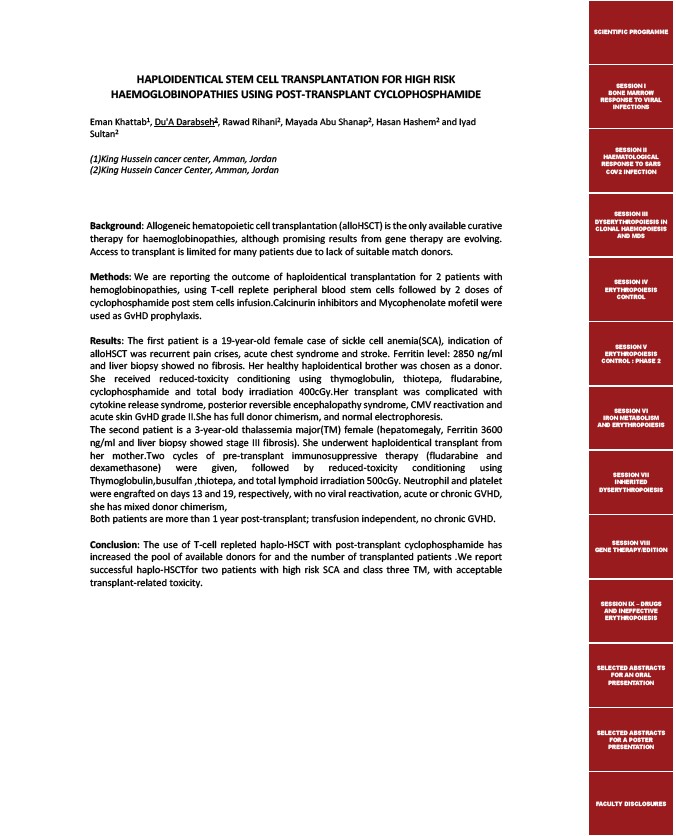
HAPLOIDENTICAL STEM CELL TRANSPLANTATION FOR HIGH RISK
HAEMOGLOBINOPATHIES USING POST-TRANSPLANT CYCLOPHOSPHAMIDE
Eman Khattab1, Du'A Darabseh2, Rawad Rihani2, Mayada Abu Shanap2, Hasan Hashem2 and Iyad
Sultan2
(1)King Hussein cancer center, Amman, Jordan
(2)King Hussein Cancer Center, Amman, Jordan
Background: Allogeneic hematopoietic cell transplantation (alloHSCT) is the only available curative
therapy for haemoglobinopathies, although promising results from gene therapy are evolving.
Access to transplant is limited for many patients due to lack of suitable match donors.
Methods: We are reporting the outcome of haploidentical transplantation for 2 patients with
hemoglobinopathies, using T-cell replete peripheral blood stem cells followed by 2 doses of
cyclophosphamide post stem cells infusion.Calcinurin inhibitors and Mycophenolate mofetil were
used as GvHD prophylaxis.
Results: The first patient is a 19-year-old female case of sickle cell anemia(SCA), indication of
alloHSCT was recurrent pain crises, acute chest syndrome and stroke. Ferritin level: 2850 ng/ml
and liver biopsy showed no fibrosis. Her healthy haploidentical brother was chosen as a donor.
She received reduced-toxicity conditioning using thymoglobulin, thiotepa, fludarabine,
cyclophosphamide and total body irradiation 400cGy.Her transplant was complicated with
cytokine release syndrome, posterior reversible encephalopathy syndrome, CMV reactivation and
acute skin GvHD grade II.She has full donor chimerism, and normal electrophoresis.
The second patient is a 3-year-old thalassemia major(TM) female (hepatomegaly, Ferritin 3600
ng/ml and liver biopsy showed stage III fibrosis). She underwent haploidentical transplant from
her mother.Two cycles of pre-transplant immunosuppressive therapy (fludarabine and
dexamethasone) were given, followed by reduced-toxicity conditioning using
Thymoglobulin,busulfan ,thiotepa, and total lymphoid irradiation 500cGy. Neutrophil and platelet
were engrafted on days 13 and 19, respectively, with no viral reactivation, acute or chronic GVHD,
she has mixed donor chimerism,
Both patients are more than 1 year post-transplant; transfusion independent, no chronic GVHD.
Conclusion: The use of T-cell repleted haplo-HSCT with post-transplant cyclophosphamide has
increased the pool of available donors for and the number of transplanted patients .We report
successful haplo-HSCTfor two patients with high risk SCA and class three TM, with acceptable
transplant-related toxicity.
SCIENTIFIC PROGRAMME
SESSION I
BONE MARROW
RESPONSE TO VIRAL
INFECTIONS
SESSION II
HAEMATOLOGICAL
RESPONSE TO SARS
COV2 INFECTION
SESSION III
DYSERYTHROPOIESIS IN
CLONAL HAEMOPOIESIS
AND MDS
SESSION IV
ERYTHROPOIESIS
CONTROL
SESSION V
ERYTHROPOIESIS
CONTROL : PHASE 2
SESSION VI
IRON METABOLISM
AND ERYTHROPOIESIS
SESSION VII
INHERITED
DYSERYTHROPOIESIS
SESSION VIII
GENE THERAPY/EDITION
SESSION IX – DRUGS
AND INEFFECTIVE
ERYTHROPOIESIS
SELECTED ABSTRACTS
FOR AN ORAL
PRESENTATION
SELECTED ABSTRACTS
FOR A POSTER
PRESENTATION
FACULTY DISCLOSURES